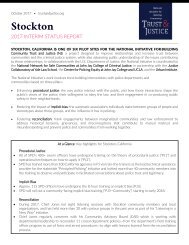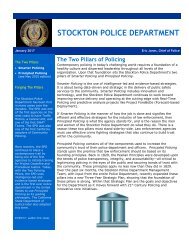SPD Strategic Report Final V1.6
You also want an ePaper? Increase the reach of your titles
YUMPU automatically turns print PDFs into web optimized ePapers that Google loves.
Stockton Police Department<br />
9<br />
community trust, police legitimacy, and reconciliation.<br />
Stockton Police Department personnel have been receiving<br />
intensive training in three areas:<br />
• Procedural Justice focuses on how the<br />
characteristics of police interactions with the public<br />
shape the public’s views of the police, the public’s<br />
willingness to obey the law, and actual crime<br />
rates. Beyond the intensive training department<br />
employees receive in this area, the department has<br />
begun assessing its employees on their ability to<br />
practice Procedural Justice and acknowledges those<br />
who show exceptional progress through special<br />
assignments, promotions, and annual evaluations.<br />
Additionally, departmental policies are being revised<br />
to integrate Procedural Justice.<br />
• Implicit Bias focuses on how largely subconscious<br />
psychological processes can shape authorities’<br />
actions and lead to racially disparate outcomes,<br />
even where actual prejudice is not present.<br />
• Reconciliation facilitates honest conversations<br />
between communities and police that allow them<br />
to address historical tensions, grievances, and<br />
misconceptions with the ultimate goal of resetting<br />
relationships.<br />
Procedural Justice will be applied throughout the<br />
department, included in policies, employee evaluations,<br />
and special assignment requests.<br />
Objective 2: Public Information Officer (PIO)<br />
The department’s Public Information Officer is<br />
tasked with answering questions from the media and<br />
disseminating press releases. We plan to expand this office<br />
to facilitate improved two-way dialog with the community,<br />
increase transparency, and communicate in a timely<br />
and accurate manner through several avenues including<br />
social media and face-to-face contact. We will continue<br />
using Facebook, Twitter, Instagram, blogging and other<br />
outreach tools to remain proactive in the dissemination of<br />
information.<br />
Objective 3: Neighborhood Impact Team (NIT)<br />
The Neighborhood Impact Team works in partnership<br />
with the Stockton Police Chaplaincy. This team, consisting<br />
of the PIO, volunteers and Community Service Officers<br />
(CSOs), goes into the community after a traumatic event,<br />
such as a homicide or an officer involved shooting. The<br />
team talks to affected community members about the<br />
incident and the many resources available to them,<br />
answers questions and helps build trust through<br />
disseminating accurate information as well as gaining input<br />
from the community.<br />
Objective 4: Chief’s Community Advisory Board<br />
(CAB)<br />
The Chief’s Community Advisory Board is comprised of<br />
a cross-section of Stockton’s civic, business and religious<br />
leaders. The CAB encourages two-way communication<br />
between the department and the community. The CAB<br />
meets with the Chief on a regular basis to share concerns<br />
on crime and police relations and to receive information on<br />
current department initiatives. Courageous Conversations,<br />
the latest project being worked on by the CAB, reaches<br />
further into the community to create additional dialogue.<br />
Courageous Conversations<br />
CAB members help shape spaces for candid dialogue<br />
with our community and facilitate town hall style meetings<br />
in schools, churches and community centers where<br />
participants are encouraged to discuss issues such as racial<br />
prejudice and police community relations.<br />
Objective 5: Operation Ceasefire<br />
Operation Ceasefire is a proven group violence<br />
intervention strategy which focuses resources on those<br />
most likely to be involved in gun violence – those most<br />
likely to shoot or be shot. Operation Ceasefire comprises<br />
a partnership of community-based organizations, service<br />
providers, and law enforcement, which communicates<br />
with those at risk through “call-ins,” offering help and<br />
resources to get out of the violent lifestyle. Those who do<br />
not take advantage of these resources and continue to<br />
engage in violence face criminal sanctions by a broad array





